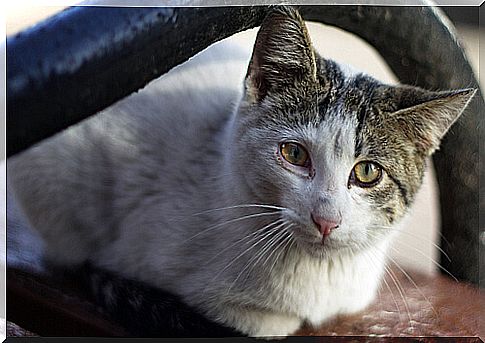Most Frequent Types Of Cancer In Cats

The set of cells that grow in an atypical way and divide without control are a threat to all living beings. Knowing which are the most common types of cancer in cats can help prevent them.
Cancer is the main cause of death in cats, and is that one in five felines can suffer from it, so it must be detected in early stages. Masses or tumors form when cells multiply rapidly. They will be malignant or benign depending on that speed and the capacity to invade other tissues; They are divided into sarcomas or carcinomas.
On the other hand, cancer that affects the bone marrow, where blood cells are made , is called leukemia. This causes large numbers of atypical cells to leak into the bloodstream and the abnormal growth of lymphocytes, a blood cell that leads to lymphoma.
How do they arise?
Genetic predisposition, exposure to sunlight or carcinogenic chemicals can be triggers for different types of cancer in cats.

Infections such as the feline leukemia virus or the feline immunodeficiency virus, favor the development of some types of cancer in cats. Fortunately, both are easy to spot.
Prevention is not always easy. Weakness and weight loss, poor appetite, lumps on or under the skin, bleeding, changes in the eyes or wounds that do not heal, require an urgent visit to the veterinarian. A strange meow, bad coat or restlessness also indicate that something is wrong.
X-rays, ultrasound, surgical or needle biopsies, as well as fine needle aspirates help detect different types of cancer in cats. Blood tests are a routine that must be carried out periodically, especially in older cats.
Computed Tomography (CT) and Magnetic Resonance are sophisticated techniques; they confirm the diagnosis and allow the best treatment to be planned.
Most common types of cancer in cats
Lymphoma or lymphosarcoma is the most common cancer in cats, and the solid tumor originates in the white blood cell called lymphocyte, related to the immune system. It can appear in several places at the same time : lymph nodes, thoracic cavity, gastrointestinal tract, nasal cavity, kidneys and nervous system.
Surgery, chemotherapy and radiotherapy are treatment options, and in these cases the response of the feline can be very favorable. Treating a cat with cancer is not always easy, but its quality of life should take priority.
Also, squamous cell carcinoma affects the skin and the sun’s rays are the triggers. The tumor usually affects the nose or ears, and may look like a scratch or wound that does not heal properly; however, metastasis is not as common.
Likewise, mammary carcinoma affects the mammary glands, often in whole females, although spayed ones are not entirely safe; and neither do the males. Multiple nodules or swollen and hardened areas are alert, and can spread to local lymph nodes and lungs.

Finally, early treatment of single, small nodules makes a difference. Removal of the tumor and its surrounding tissues, and sometimes chemotherapy, are combat mechanisms.
Aggravators to handle with great care
- Mastocytoma affects the skin, spleen or intestines, where it is usually very aggressive, as it causes obstruction. It easily metastasizes, especially to the lymph nodes, lungs, liver, or spleen. Surgery, radiation therapy, or chemotherapy are curative options for this case.
- Oral squamous cell carcinoma begins in cells that line the mouth or throat. It affects the tongue, occasionally invades the bone and local lymph nodes, and often causes difficulty eating, salivation, and halitosis. It should be noted that it is difficult to treat.
- Fibrosarcoma or soft tissue sarcoma. It is formed from connective tissues, under the skin. Combining surgery with radiotherapy and chemotherapy is recommended; the prognosis is variable.
- Osteosarcoma affects the bones of the extremities, spine, or skull. It causes fractures, a lot of pain and lameness, and can spread to the lymph nodes and lungs. Again, surgery, radiation therapy, and chemotherapy can be a solution.
In the lungs
- Respiratory, nasal or lung carcinoma is the most frequent in the nose and lungs. It causes shortness of breath, snoring or snorting, sneezing, coughing, and nasal discharge. It can spread to the bones and has usually metastasized by the time clinical symptoms occur. Surgery and chemotherapy are effective alternatives.
- Adenocarcinomas affect the intestine, large and small, which invade extensively. They grow very fast, cause loss of appetite, weight, vomiting and diarrhea; In addition, it usually spreads to local lymph nodes and the indicated treatment is surgery.
- Pancreatic and hepatic adenocarcinomas of the bile ducts are not very frequent. They cause jaundice, depression, weight loss, vomiting, and bloating. The prognosis, unfortunately, is usually negative.









